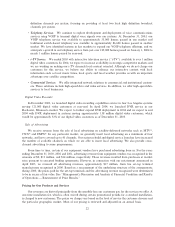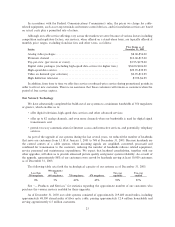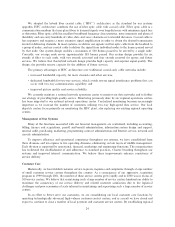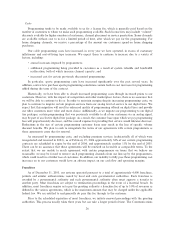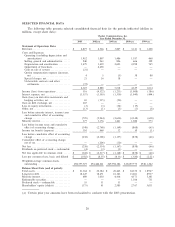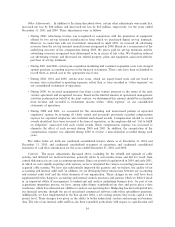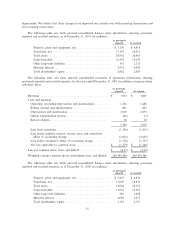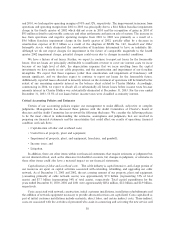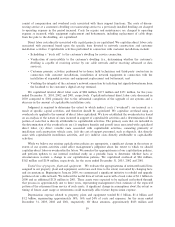Charter 2003 Annual Report Download - page 32
Download and view the complete annual report
Please find page 32 of the 2003 Charter annual report below. You can navigate through the pages in the report by either clicking on the pages listed below, or by using the keyword search tool below to find specific information within the annual report.Historically, our ability to fund operations and investing activities has depended on our continued access
to credit under our subsidiaries' credit facilities. While our use of cash has changed over time such that the
substantial majority of our cash now comes from cash Öows from operating activities, we expect we will
continue to borrow under our subsidiaries' credit facilities from time to time to fund cash needs. The
occurrence of an event of default under our subsidiaries' credit facilities could result in borrowings from these
facilities being unavailable to us and could, in the event of a payment default or acceleration, also trigger
events of default under our notes and our subsidiaries' outstanding notes and would have a material adverse
eÅect on us. Approximately $188 million of indebtedness under our subsidiaries' credit facilities is scheduled
to mature during 2004. We expect to fund payment of such indebtedness through availability under our
subsidiaries' revolving credit facilities.
Adoption of New Policies
Commencing in January 2002 and continuing through the Ñrst quarter of 2003, our management elected
to implement a number of new policies including:
Change in Disconnect and Bad Debt Policies. Our estimated customer count is intended to include those
people receiving cable service (regardless of payment status), except for complementary accounts (such as
our employees). Our disconnect and bad debt guidelines for slow or nonpaying customers provide that, in
general, customers are to be terminated for non-payment after approximately 60-75 days, and written
oÅ/referred to collection at approximately 90-110 days. We initially began implementing this policy in
January 2002 after we decided to change our past practice under which we did not promptly disconnect these
customers on a uniform basis. EÅective year-end 2001, we also increased our allowance for doubtful accounts.
The number of our customers who are presently more than 90 days overdue and our bad debt expense
associated with such customers are lower than they were prior to the institution of these policies.
Procedures to ensure adherence to Disconnect and Customer Count Policies. During our review of
internal audit Ñndings and in the course of internal investigations, and subsequently in the course of responding
to governmental investigations, we became concerned that certain employees either were not or had not
previously been complying with our customer count and disconnect policies. We have since announced to our
employees that a failure to follow these polices will be met with disciplinary action including, in appropriate
cases, termination. We have terminated and disciplined employees who have not followed the policies. We
have instituted regular review of customer reports by senior employees in an eÅort to ensure adherence to our
policies and consistency of application throughout our various operating divisions, and we have established a
telephone hotline number for employees to call and report misconduct relating to the reporting of customer
numbers. We have also elected not to provide guidance on expected customer numbers in our public
disclosures.
Corporate Compliance Program. Prior to 2002, we did not have a formal compliance program. We have
since established a corporate compliance program, pursuant to which we provide a revised Code of Conduct to
our employees that is incorporated into our Employee Handbook. The Code and Handbook require that
employees report violations of the Code or other behavior which they believe might be unethical or illegal.
Employees can report matters to their supervisor, to the Human Resources Department, through a hotline or
through a secure website, and may do so anonymously. The compliance program is overseen by a compliance
committee comprised of our high-ranking oÇcers, which meets on a quarterly basis. The head of the
committee in turn reports to the Audit Committee.
Treatment of Data Only Customers. We have changed our methodology for reporting analog cable
video customers to exclude those customers who receive high-speed data service only. This represents a
change in our methodology from prior reports through September 30, 2002, in which high-speed data service
only customers (which numbered approximately 55,900 at September 30, 2002) were included within our
analog cable video customers. We made this change because we determined that a substantial number of
those customers who only received high-speed data service were unable to receive our most basic level of
analog video service because this service was physically secured or blocked, was unavailable in certain areas or
the customers were unaware that this service was available to them. In addition, in light of our decision to
30




